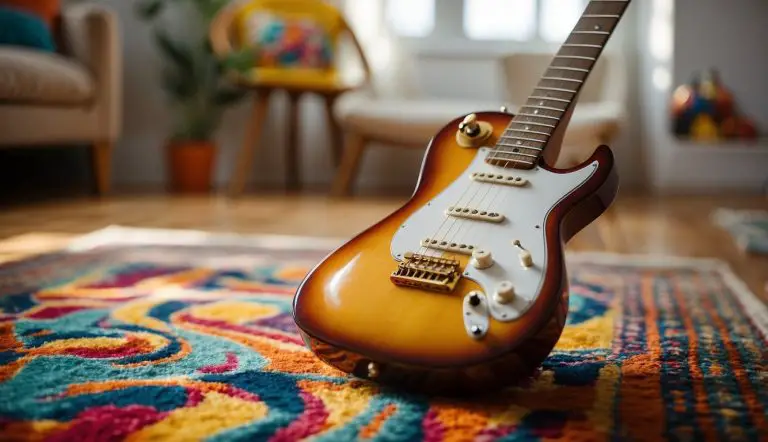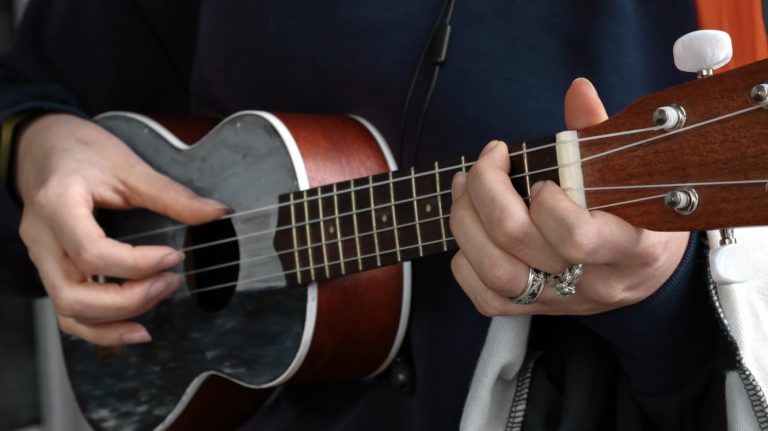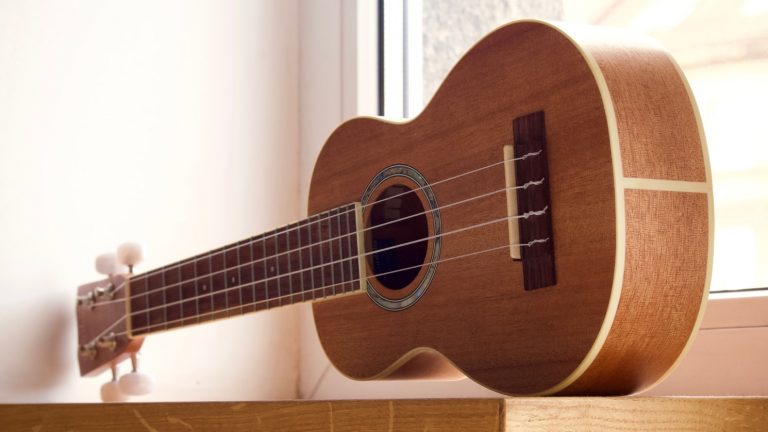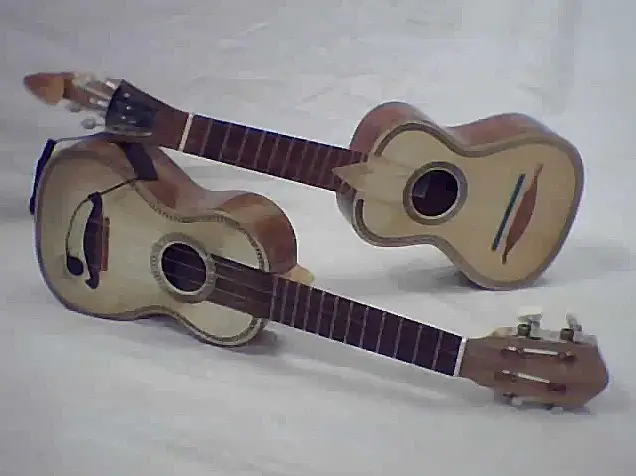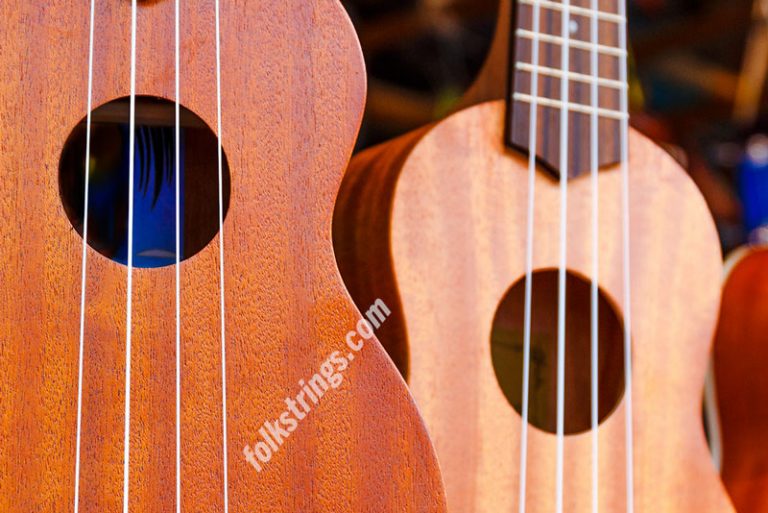How to Pick a Ukulele for Beginners: Your Easy Guide to Strumming Success
Folkstrings.com is reader-supported. When you buy through links on our site, we may earn a small commission.
Choosing the right ukulele as a beginner can be as exciting as it is intimidating. My journey into the realm of music began with the invigorating task of selecting my first ukulele. I quickly learned that the size and type of the instrument would greatly affect my learning experience.
The small size of a ukulele entices many beginners due to its portability and relative ease compared to other stringed instruments.
Knowing the basics of different ukulele sizes — from soprano to baritone—helped me match my music aspirations with the right fit.
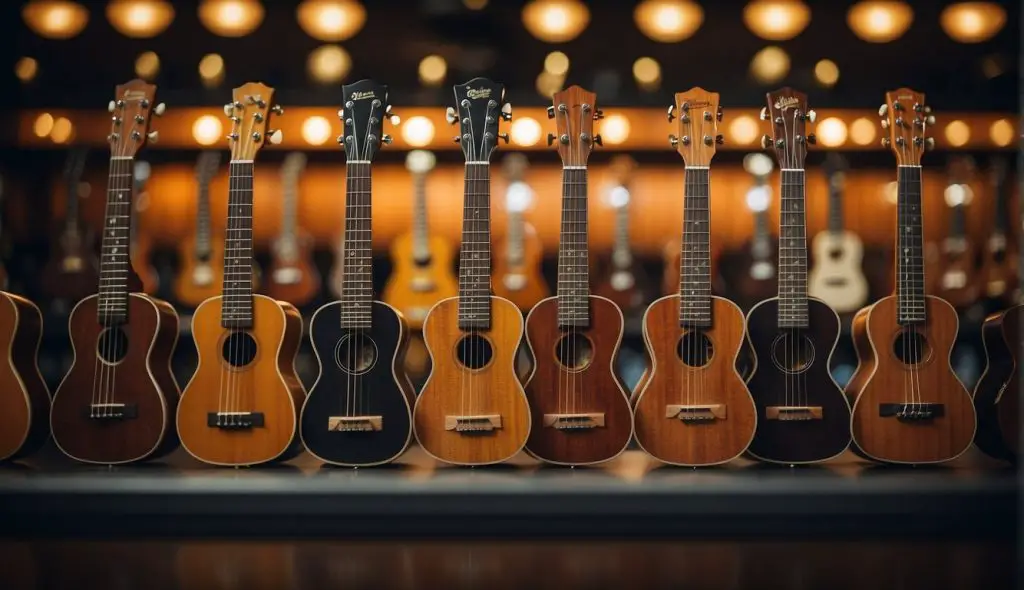
Understanding my budget was vital in narrowing down my choices. Rather than focusing solely on the price, I evaluated the value of the ukulele in terms of quality, sound, and durability. High-quality ukuleles tend to provide better sound and a more enjoyable playing experience, which is fundamental for any beginner to stay motivated.
Additionally, I sifted through the most common questions beginners have, finding answers that clarified my doubts and reaffirmed my choices.
With my new ukulele in hand, the first steps of learning felt less daunting. I took comfort in knowing I had chosen an instrument that suited my beginner status, my budget, and my eagerness to delve into the music world. The initial chords and melodies I played reassured me that my selection process was a success, setting me on a path of musical discovery and fulfillment.
Key Points
- Selecting a size that suits personal comfort and music goals is crucial.
- Budget considerations are key, but seek value in terms of quality and sound.
- Answering common beginner questions provides clarity and enhances the selection process.
Table of Contents
My 3 Top Picks of Ukuleles for Beginners
When starting on the ukulele, choosing the right instrument is crucial. I’ve played several ukuleles that strike the perfect balance between quality and playability for beginners. Here are my top three picks for those just starting their ukulele journey:
- Kala KA-15S Mahogany Soprano Ukulele
- Body: Mahogany
- Size: Soprano
- Unique Feature: Rich, full sound
- Why I Recommend It: The Kala KA-15S is a fantastic choice for beginners due to its comfortable soprano size and its warm, pleasant tone. It’s easy on the fingers, and the mahogany body ensures durability.
- Donner Concert Ukulele Mahogany DUC-1
- Body: Mahogany
- Size: Concert
- Unique Feature: Bundle includes accessories
- Why I Recommend It: The Donner Concert Ukulele comes in a kit that’s perfect for beginners, complete with a tuner, case, and strap. The slightly larger concert size offers a fuller sound and more space between frets, which can be helpful for those with larger hands.
- Lanikai LU-21 Soprano Ukulele
- Body: Nato Wood
- Size: Soprano
- Unique Feature: Easy to tune
- Why I Recommend It: Lanikai is known for making great beginner instruments, and the LU-21 is no exception. It has a smooth, clear sound and maintains its tune well, making it less intimidating for beginners to start playing.
These are accessible in terms of price and playability, making them fantastic choices for anyone looking to embark on their musical journey with the ukulele.
Choosing the Right Size
When I started on my ukulele journey, I found choosing the right size instrumental to the playing comfort and sound I was aiming for. Each ukulele size offers a distinct tone and scale length which may suit different hand sizes and musical styles.
Soprano Ukuleles
Soprano ukuleles are the smallest and most traditional of the ukulele family, which makes them highly portable. Their scale length—the distance from the nut to the saddle—is typically around 13 inches. I find that this size fits well with those who have smaller hands. The soprano ukulele produces a classic bright and soft ukulele tone that’s synonymous with Hawaiian music.
Concert Ukuleles
Slightly larger, the concert ukulele usually has a scale length of about 15 inches. If your hands are a bit larger, a concert ukulele may feel more comfortable for you. The added size translates to a fuller sound and more mid-range tones when compared to the soprano. It’s a great middle-ground choice for both beginners and experienced players.
Tenor Ukuleles
I’ve noticed that tenor ukuleles, with a scale length typically around 17 inches, offer a deeper sound that’s closer to that of an acoustic guitar. They cater to players looking for more room on the fretboard, which is particularly friendly for those with larger hands. The tenor size provides a warm tone that supports more versatile playing styles and a wider range of musical notes.
Baritone Ukuleles
Baritone ukuleles are the largest, with a scale length of around 19 to 21 inches. These are tuned differently from the other sizes, usually to DGBE—the same as the top four strings of a guitar—which gives them a much deeper tone. If you’re transitioning from the guitar or enjoy a robust and rich sound, the baritone might be a perfect fit. It’s suited for players who are comfortable with a larger fretboard and those who seek a bass-heavy tone.
Understanding Ukulele Basics
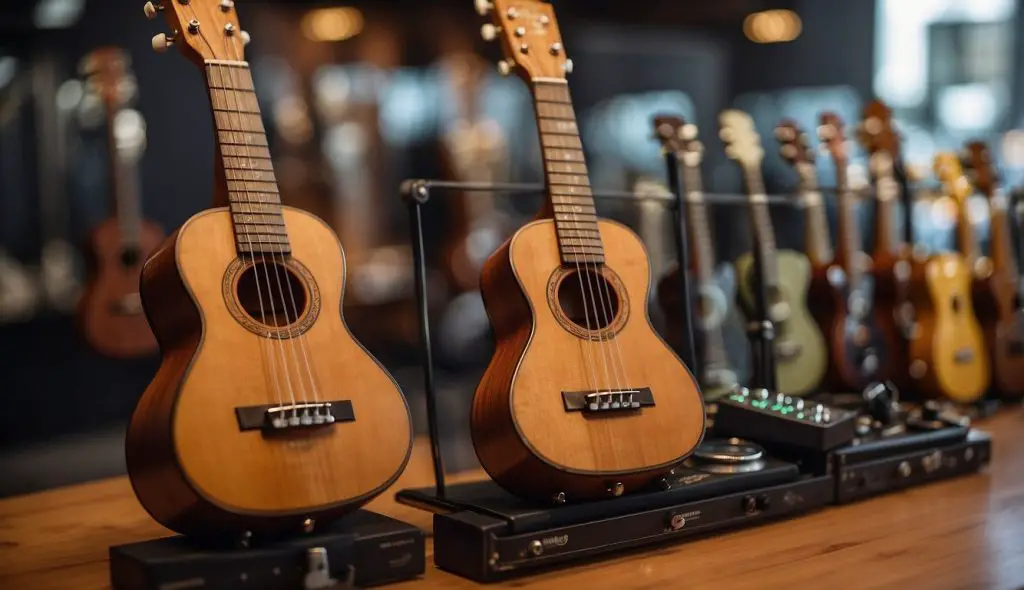
Before diving into playing your ukulele, it’s essential to get familiar with the fundamentals. I’ll walk you through the three basic aspects: the parts of the ukulele, how to tune it properly, and the foundations of chords and strumming. This will ensure you have a solid understanding to build upon.
Parts of the Ukulele
The ukulele typically consists of four main parts: the body, neck, headstock, and bridge. Here’s a quick overview:
- Body: Houses the sound hole, and it’s where sound vibrates. It includes the top, back, and sides.
- Neck: The long part where you’ll find the frets.
- Headstock: At the end of the neck, holds the tuning pegs or machine heads.
- Bridge: Anchors the strings to the body, along with the nut at the top of the fretboard.
Remember that the smallest string produces a high ‘A’ sound, followed by ‘E’, ‘C’, and ‘G’, with the ‘G’ being closest to you when you hold the ukulele.
Tuning Your Ukulele
Tuning a ukulele is crucial for the right sound. Here’s a guideline using standard G-C-E-A tuning:
- Start with the top string (G), and use a tuner or tuning app to get the right pitch.
- Proceed to the C string, then the E string, and finally the A string.
- Ensure each string resonates clearly when plucked.
A well-tuned ukulele makes learning and playing much easier.
Basic Chords and Strumming
Understanding basic chords and strumming patterns is essential. These are the first few chords I learned:
- C Major: Place your ring finger on the third fret of the A string.
- G Major: Use three fingers to press the second fret of the C and A strings, and the third fret of the E string.
- F Major: Hold down the second fret of the G string with your index finger and the first fret of the E string with your thumb.
For strumming, keep a relaxed wrist and strum down and up in a steady rhythm. You can begin practicing with simple downstrokes on each beat and progress to more complex patterns as you get comfortable. As you master these chords and strumming patterns, you can start playing songs and build a repertoire.
Selecting a Ukulele Within Your Budget
When I started on my ukulele journey, I quickly learned that finding the right instrument within my budget was crucial. It needed to be cost-effective without compromising on quality.
Price Point Considerations
Budget is the starting point for choosing a ukulele. Ukuleles come in various price ranges. Cheap ukuleles can start as low as $20, while high-end models can climb over $200.
I always recommend beginners to aim for the mid-range price points. These are anywhere between $50 to $100. This often ensures a balance of quality without over-investment.
Among the well-regarded brands, Kala and Cordoba offer models such as the Kala Venice Soprano Ukulele and the Cordoba Rincon Tenor Ukulele. These are fantastic options within an affordable range.
Spotting Quality Features
The build quality of a ukulele is a telltale sign of how well it will play and last. I look for a solid wood construction, with mahogany being a personal favorite for its warm tone and durability.
Solid wood ukuleles are typically more expensive. However, they offer richer sounds than laminate woods. It’s pivotal to inspect the finish, the smoothness of the fretboard, and the sturdiness of the tuning pegs. These aspects often indicate a well-built ukulele.
Accessories to Consider
When purchasing a ukulele, I’ve found that some accessories are essential. A good case protects the instrument from dust and damage, while a tuner ensures my ukulele sounds its best.
Sometimes, budget ukuleles may come in packages with these accessories included. This offers more value for money. I always factor in the cost of necessary accessories when I set my budget for a new ukulele.
First Steps to Playing
Before I dive into playing the ukulele, I must emphasize the importance of starting simple with one song, practicing regularly, and utilizing a variety of resources to cement my learning.
Learning Your First Song
I always recommend that as a beginner, I choose a simple song to learn first. This could be something like Twinkle, Twinkle, Little Star or You Are My Sunshine, which consist mostly of basic chords.
To ensure I don’t feel overwhelmed, I keep my focus narrowed to learning the chords and strumming pattern of that one song.
- Chords: Start with C, G, Am, F.
- Strumming: Practice a simple down-up pattern.
Practicing Consistently
To get better at the ukulele, consistency in practice is crucial for me. I set aside at least 10 minutes daily to play.
Here’s a small timetable I follow to keep my practice structured:
| Day | Activity | Duration |
|---|---|---|
| Mon | Chord practice | 10 min |
| Tue | Strumming | 10 min |
| Wed | Full song | 10 min |
| Thu | Chord switching | 10 min |
| Fri | Full song | 10 min |
Exploring Further Resources
After getting comfortable with my first song, I look for additional resources like a beginners’ ukulele guide or interactive gear guide.
These resources are incredibly helpful for understanding which ukulele is best suited for me and how to care for it. They also help me find more songs that beginners find manageable.
- Interactive Gear Guide: Helps me choose the right ukulele.
- Beginners’ Guide: Offers structured lessons and tips.
Frequently Asked Questions
In this section, I’ll walk you through some of the common questions first-time ukulele buyers have. I want to make it simple for you to find the perfect ukulele to start your musical journey.
What features should I consider when choosing a ukulele for the first time?
When picking your first ukulele, look for a comfortable neck, smooth frets, and accurate tuners.
The build quality should be sturdy, but the instrument itself shouldn’t feel too heavy in your hands.
Which size ukulele would be best for a complete beginner?
A soprano ukulele is often recommended for beginners due to its smaller size and the bright, traditional sound it produces.
It’s easier to handle, especially for those with smaller hands or children.
What are some recommended ukulele brands for someone just starting out?
Kala, Mahalo, and Lanikai provide great entry-level ukuleles. These brands are known for their good quality and affordability.
They are friendly for beginners and frequently suggested by music instructors.
How does the type of wood used in a ukulele affect its sound and playability for new players?
The wood impacts the tone and resonance of the ukulele. For instance, mahogany offers a warm tone, while koa wood provides a rich and full sound.
However, for beginners, laminate wood ukuleles are durable and less expensive, offering a suitable quality to start learning.
Should I start with a soprano, concert, or tenor ukulele as a newcomer to the instrument?
Begin with a soprano for its classic ukulele sound and manageable size. A concert ukulele is slightly larger with a fuller sound, which can be a good middle ground.
Tenor ukuleles have a deeper tone and may be more comfortable for players with larger hands.
How does one assess the quality and playability of a ukulele when purchasing it for learning?
Check for a straight neck, evenly spaced frets, and smooth tuning pegs that hold their tune. The strings should be a comfortable distance from the fretboard.
This makes it easy to press down without too much effort.
Playability is essential, so the ukulele must feel good in your hands.
Author Profile
-
Daniel Johnstone is an English writer with a love for stringed instruments from around the world.
He shares his love for these instruments through his writing for folkstrings.com, a website dedicated to all things related to folk string music.
Daniel's passion for music started at a young age, and he has since become an accomplished musician, playing guitar, cavaco, and recently, the harp.
His dedication to learning and sharing his knowledge of stringed instruments is evident in his insightful and engaging blog posts. Whether you're a seasoned musician or a beginner, Daniel's writing is sure to inspire and entertain you.
When he's not playing music or writing, you can find Daniel exploring new instruments and seeking out new sounds to share with his readers.
Latest entries
 AutoharpApril 4, 2024What Is the Autoharp Made Of: Exploring Its Materials and Craftsmanship
AutoharpApril 4, 2024What Is the Autoharp Made Of: Exploring Its Materials and Craftsmanship AutoharpApril 4, 2024Is Autoharp Easy to Play? Unveiling the Truth for Beginners
AutoharpApril 4, 2024Is Autoharp Easy to Play? Unveiling the Truth for Beginners AutoharpApril 4, 2024What Is an Autoharp Worth? Your Guide to Pricing and Value
AutoharpApril 4, 2024What Is an Autoharp Worth? Your Guide to Pricing and Value AutoharpApril 4, 2024Are Autoharp and Zither the Same Thing? Unraveling String Instrument Myths
AutoharpApril 4, 2024Are Autoharp and Zither the Same Thing? Unraveling String Instrument Myths
Affiliates:
This post may contain affiliate links that at no additional cost to you, the site may earn a small commission. We only recommend products we would use ourselves and all opinions expressed on this site are our own.
Accuracy Advice:
While we strive to provide up-to-date and accurate information, the content in this article may not reflect the most current research or medical guidelines. We encourage readers to do further research and consult with professionals for more personalized advice.
Our Recommendations:
The products and services mentioned in any of our articles are recommended based on our independent research and personal experience. We are not sponsored by any company. We aim to suggest products and services we believe are of high quality and could be beneficial to our readers.


